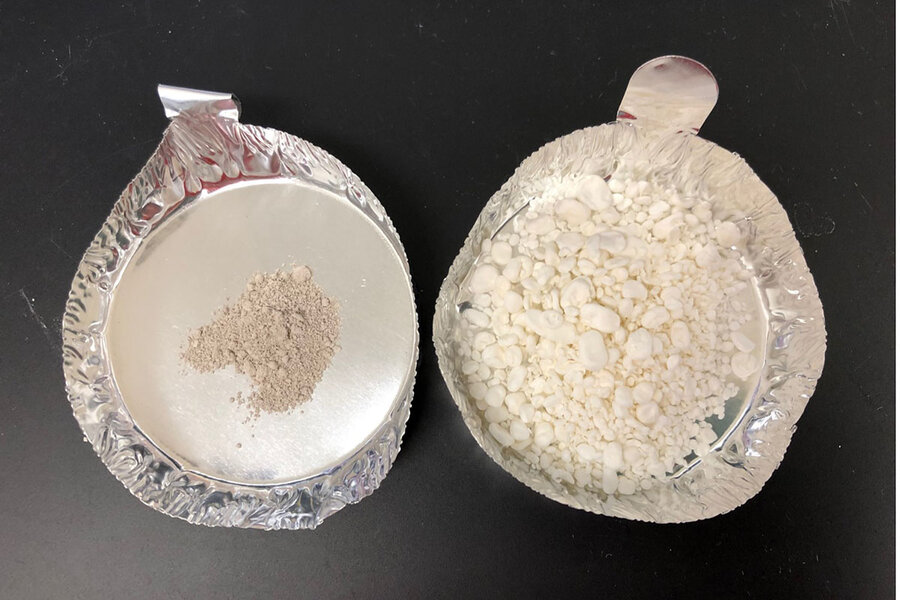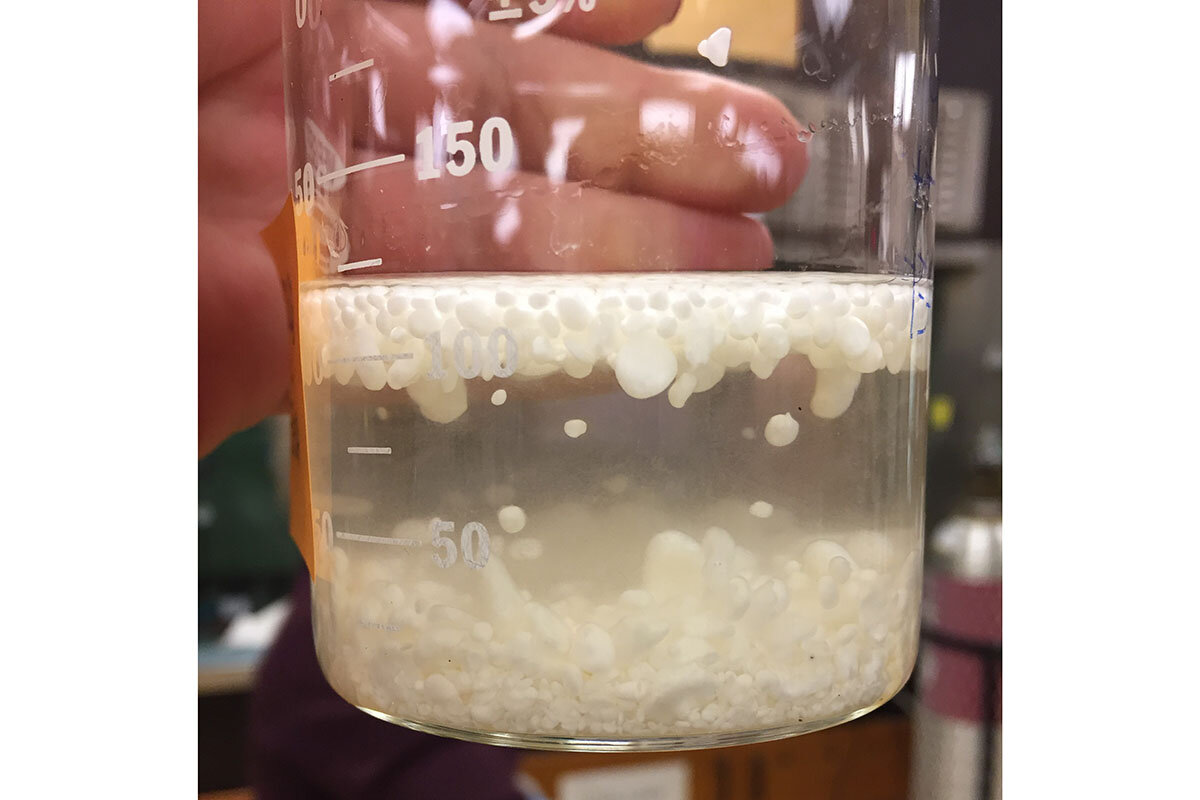Science on the half shell: Mussels yield new material
Loading...
When she first saw it, Francesca Kerton thought someone must be playing a prank.
The white blobs didn’t belong there, thought Dr. Kerton, a chemistry professor at Memorial University in the Canadian province of Newfoundland. They were soft and pliable, and they had emerged from mussel shells made of calcium carbonate, which is famously hard and brittle.
But, sure enough, when they repeated the experiment, that spongy stuff appeared again.
Why We Wrote This
Necessity may be the mother of invention, but serendipity is the eccentric aunt who keeps things interesting. As this story shows, good science requires a little of both.
Being scientists, they poked and prodded the baffling blobs. They ripped the material apart like cotton candy, stuck it back together, stretched it, and squeezed it so that water seeped out like it would from a soggy sponge.
“We did have a lot of fun in the lab acting like kids, because we hadn’t come across anything like this before, trying to figure out what it was and what we could do with it,” Dr. Kerton says.
It turns out the mystery material was still made up of calcium carbonate. And, given its spongy properties, this substance might just prove useful for ocean cleanups or biomedical purposes. The researchers reported their discovery in a paper published Thursday in the journal Matter.
This study is an example of the importance of curiosity-driven science in developing our knowledge about the world around us, says Peter Fratzl, director at the Max Planck Institute of Colloids and Interfaces in Potsdam, Germany, who was not involved in the new paper.
“It’s curiosity that wants us to understand why and how it works, but then knowing why and how it works, you can put it to use in other contexts. And, of course, you never know before you do the study what is going to be useful,” he says. “Serendipity in science is a very well-known effect.”
Blob and weave
The experiment began with a proposition from representatives from the local aquaculture industry. They’d noted that the industry was producing more mussels and processing many for export, leaving behind piles of shells as a waste product. Could Dr. Kerton turn those mussel shells into something useful, they asked.
She brought the question to her lab and they began toying with concepts. “Because we’re in Canada,” Dr. Kerton says, “our idea was to make a new de-icer” for roads. They started with a basic experiment: grinding up the shells and mixing them with acetic acid, the chemical found in vinegar.
That’s when the baffling blobs appeared.
Calcium carbonate – the main component of mussel shells, pearls, and the shells of many other marine organisms – is highly reactive with acid, so the shells should have dissolved completely. So how exactly did the hard shells become soft and squishy sponges? Was there something specific to acetic acid that made the reaction yield spongy stuff?
Questions still remain, but it might have something to do with a sort of protein glue that was in the shells before they entered the acetic acid solution. Dr. Kerton explains that calcium carbonate crystals are tightly packed in the shells like a brick wall, held together by organic material. And the reaction with acetic acid, she says, likely loosened that glue enough for the crystals to rearrange into a softer overall material. How much protein glue is needed to produce the spongy stuff remains a question, Dr. Kerton says.
The spongy substance is not exactly a new form of calcium carbonate, says Fiona Meldrum, a professor of inorganic chemistry at the University of Leeds who was not part of the new study. Instead, she says, the added organic material makes it a composite.
Still, she says, “It’s an interesting material, and it would be fascinating to look into this further, and find out why it was produced and why it has the properties that it does.”
Mussel bound
Dr. Kerton and her team largely focused on what this spongy material might be used for – probably not the de-icer they’d been aiming for.
Due to the high surface area on the “mussel sponge,” as Dr. Kerton calls it, the team’s first thought was that it might be able to absorb pollutants. Sure enough, when they stuck a bit of the sponge in seawater with oil in it, the oil would stick to the sponge and the researchers could pull it out, clean it off, and stick the sponge back in the water to keep the cleaning process going. They also tried absorbing colored dye out of water. Indeed, “the mussel sponge became colored and the solution became colorless,” she says.
It’s yet unclear whether production of this material could be scaled up enough to make a difference in the vast oceans of the world, for example, but it’s an intriguing proposition, Dr. Fratzl says. Currently, cleaning oil out of water is a difficult and expensive process. An absorbent material made from mussel shells would be quite a bit cheaper, he says, and it would be a way to use aquacultural waste.
Although Dr. Kerton is driven to find useful applications in her work, she also says it’s important for scientists to maintain a sense of simple wonder – and fun – about their research.
“All scientists, I think, they’re really just like big children. They just don’t stop asking questions. A lot of parents get annoyed with their children for asking ‘why,’” she says. “Scientists haven’t lost that sense of curiosity.”
As other aspects of a researcher’s career become more of a focus, scientists can get a bit serious, Dr. Kerton says. “It takes these unexpected things to get your mojo going again, getting your joy and curiosity.”







